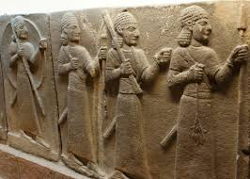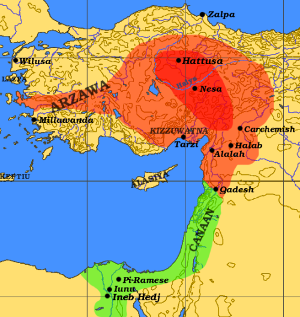The Hittites
The people who came to be known as the Hittites migrated from the east to the ancient land of Anatolia, which is now Turkey. They arrived before 2000 B.C. and encountered two other peoples already living there: the Hattians and Hurrians. The three peoples gradually merged, possibly through conquest by the Hittites. By this time, a neighboring power was the Assyrians. 
Generally regarded as the founder of the Hittite Kingdom was a singular figure known in various sources as Labarna I or Hattusili I. The capital he established at Hattusa. The king lived so long that his grandson, Mursili I, succeeded him. This king was the first of several who ranged far and wide, conquering neighboring lands. In his case, it was south into Babylonia, driving out the Amorites, whose most famous ruler was Hammurabi. Historians divide the Hittite era into three periods: the Old Kingdom, the Middle Kingdom, and the New Kingdom. The Hittite expedition into Babylonia wasn't exactly what the invaders expected it to be, and the Hittites struggled through a series of weak rulers and succession controversies before a strong monarch named Telepinu came to the throne, about 1500 B.C. He proved to be a short-term king, however (and the last of the Old Kingdom). The Middle Kingdom was known much more for instability than for the kings who ruled during this period. The Hittites faced sporadic invasions from various neighbors, including the Mittani, victims of a Hittite conquest drive a few years earlier. 
A century later, another strong monarch emerged and knitted the kingdom back together. Tudhaliya I was the first of the New Kingdom monarchs. This period was also known as the Hittite Empire era. The king was head of the government, the army, and the state religion. The monarchs during this time were so powerful and so awe-inspiring that they could command their subjects to consider the king as superhuman, nearly a god. The army, a mixture of infantry and charioteers, was efficient and, in later years, was more of a standing army; at the same time, these troops signed on not so much for regular pay as for a share of whatever money, jewels, and whatever else they could claim as the result of a military victory. The Hittites reveled in the defeat of their regular enemy the Mittani, victims of a devastating conquest at the hands of the Assyrians. What this meant in practice, however, is that Assyrian-own lands now bordered the Hittite Empire. Another strong monarch, one of the most well-known Hittite kings ever, arose about 1350 B.C.; this was Suppiluliuma I. Under his leadership, the Hittites grew in stature, army size, and territory controlled to be roughly equal with the extremely powerful neighboring civilizations of Assyria and Egypt. When the Egyptian pharaoh Tutankhamen died, his widow sought to marry a son of Suppiluliuma I in order to cement an alliance between the two civilizations. (The son never reached Egypt; on the way, he was killed, by Egyptian leaders who didn't want the alliance.) 
The death of Suppiluliuma I led to the reign of his oldest son, Mursili II. This king expanded the borders and influence of Hittite lands even further and, after reigning for 25 years, gave way to his son, Muwatalli II. This king it was who commanded the Hittite forces at the famous Battle of Kadesh, which featured Egypt's famous pharaoh Ramses II and a variety of other neighboring forces that is thought to have been the largest chariot battle in world history. (Who won this battle depends on whichever source is consulted.) A later Hittite ruler, Hatusilli III, entered into a peace treaty with Egypt; the resulting Treaty of Kadesh was one of the first known peace treaties in recorded history. Ramses II was still the Egyptian monarch at this time. This was the high-water mark of the Hittite Empire. Eventually, the strength of the neighboring Assyrians was too much to overcome, and Assyria essentially annexed most Hittite lands. An Assyrian victory in the 1245 B.C. Battle of Nihriya accelerated the transition. In the diaspora that followed, some remnants of the former Hittite glory could be seen in and around Anatolia. The last known Hittite king was Suppiluliuma II, who presided over a victory over Cyprus in the first known naval battle, in 1210 B.C. He died in 1190, when Hattusa itself was sacked. The conquering Assyrians made a habit of stamping out remnants of the people that they conquered, so what is left of Hittite culture and tradition is few and far between. What is known about this ancient people comes from their own sources that did survive and from sources from neighboring civilizations. The Hittites were known to have used their own language to a certain extent but to have written in the script used by another ancient people, the Akkadians. One famous example is a collection of tablets on which various laws are written. Some Hittite art and architecture survives and has been discovered at Hattusa and elsewhere. |
|
Social Studies for Kids
copyright 2002–2026
David White




